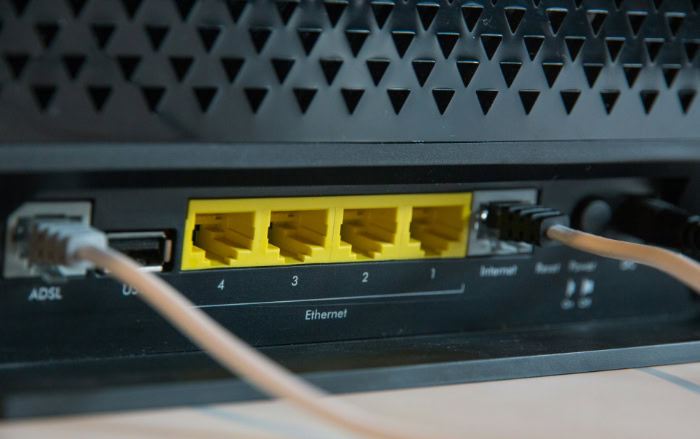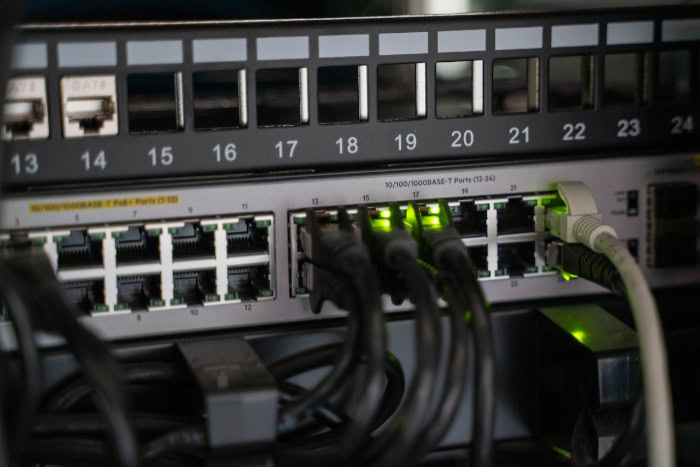What Is an Ethernet Port? How It Powers Fast Internet

Wired connections might seem old-fashioned in a world buzzing with Wi-Fi, but there's a hidden reason Ethernet ports continue to appear on everything from laptops to smart TVs. These small, almost overlooked sockets offer far more than just a place to plug in a cable.
They promise a rock-solid connection, blazing-fast speeds, and a level of security that even the best wireless networks struggle to match.
Core Components of an Ethernet Port
An Ethernet port, often referred to as an RJ45 port, sports a distinctive rectangular shape designed to accommodate an RJ45 connector. Featuring eight small metal pins inside, the port is built for efficiency, transmitting and receiving data across all eight lines.
The structure allows for quick insertion and removal of Ethernet cables, enabling secure and reliable connections.
A comparison to the older RJ11 phone jack highlights how Ethernet ports differ from legacy networking hardware. While an RJ11 port is smaller and typically uses only four or six pins for analog phone signals, the RJ45 connector supports much faster and more robust digital data transfer.
The extra pins and larger size help to facilitate the higher bandwidth required for modern networking tasks, making the Ethernet port both physically and functionally superior for internet and network connectivity.
Common Devices with Ethernet Ports
Ethernet ports can be found on a wide range of devices that benefit from stable, high-speed connections. Home routers and modems are perhaps the most familiar, serving as the central hub for wired networks.
Many laptops, especially those designed for business or gaming, include an Ethernet port to provide faster speeds and lower latency compared to Wi-Fi. Gaming consoles, where split-second responsiveness matters, often feature Ethernet ports for uninterrupted online play.
Smart TVs take advantage of wired connections to stream high-definition content smoothly, while media players and set-top boxes also rely on Ethernet for consistent performance. In business environments, servers and desktop computers almost always include Ethernet ports, ensuring seamless communication and fast data transfers across internal networks.
Ethernet switches, used to expand the number of available ports, further illustrate how prevalent and important these connectors remain across both home and professional settings.
Functionality and Key Benefits

Reliable networking starts with a clear transmission path, and Ethernet ports play a vital role in how devices communicate across local and wide-area networks. They provide the physical connection needed for high-speed data transfer, taking networking beyond the limits of wireless signals.
The way Ethernet works and the advantages it offers set it apart, especially for those who value speed, stability, and security.
How It Works
An Ethernet connection relies on a few essential components to function smoothly. At the device level, a Network Interface Controller, or NIC, manages the conversion of digital data into signals that travel over Ethernet cables.
The port itself serves as the access point where the cable connects, creating a direct channel for communication between computers, routers, modems, or switches.
Data travels as electrical signals along the cable, passing through the Ethernet port and heading to a router or switch. The modem then translates these signals into a format suitable for transmission across the internet or other networks.
The process ensures minimal data loss and consistent connection quality, since each device in the chain has a specific role in passing along the data efficiently. The structured, point-to-point nature of this transmission creates a fast and dependable link, allowing large volumes of information to be sent with very little delay.
Advantages Over Wireless
While Wi-Fi brings the convenience of mobility, Ethernet stands out for its unmatched reliability and performance. Wired connections are far less susceptible to signal interference from physical barriers or nearby electronic devices, so users can expect consistent speeds at all times.
Lower latency means information moves from one device to another almost instantly, which is crucial for activities like online gaming, video conferencing, and streaming high-definition content.
Security also sees a boost with Ethernet. Since a physical connection is necessary to access the network, unauthorized users have a much harder time breaching defenses compared to wireless signals, which can be intercepted from a distance.
This added layer of protection is essential for organizations and individuals who handle sensitive information.
For environments where a stable, high-speed, and secure connection is non-negotiable, Ethernet ports provide the direct link required to keep performance at its best. The combination of reliable signal transmission, low latency, and enhanced security explains why wired connections continue to be the preferred choice for demanding tasks and professional settings.
Practical Applications and Use Cases

Ethernet ports prove their value most clearly in settings where speed and reliability matter. As people continue to demand more from their home and office networks, the scenarios that benefit from a wired connection have grown.
From high-stakes gaming sessions to mission-critical business systems, Ethernet connections consistently outperform wireless alternatives in both performance and dependability.
Ideal Scenarios for Wired Connections
High-performance gaming, streaming ultra-high-definition video, and transferring large files all place heavy demands on network infrastructure. In such applications, even momentary drops in speed or signal can ruin the experience.
Gamers, for instance, often rely on Ethernet ports to minimize latency, ensuring that every move in a fast-paced online match registers instantly. The stability of a wired connection keeps competitive players a step ahead, free from unpredictable lag or disconnects.
Streaming 4K video requires an uninterrupted, high-bandwidth link. Ethernet provides the steady throughput needed for flawless visuals without buffering or image degradation.
Professionals handling large data sets or creative works also turn to Ethernet for transferring files swiftly and securely. In office environments, wired networks support a wide array of devices and users, maintaining consistent performance even during peak usage.
Industrial settings rely on Ethernet for more than just convenience. Machinery, servers, and control systems often depend on wired connections to guarantee up-to-the-second communication and avoid costly downtime.
The reliability of Ethernet makes it a preferred choice for connecting equipment that cannot afford to lose connectivity, even for a moment.
Troubleshooting Common Issues
While Ethernet ports are known for reliability, some issues can still arise. Diagnosing connectivity problems starts with a thorough check of the hardware.
Sometimes a port may become loose or damaged, resulting in an unstable or completely lost connection. Swapping cables or testing the port with a different device can quickly reveal where the fault lies.
Cable problems often masquerade as bigger network issues. Bent or frayed Ethernet cables may cause intermittent drops in connection or slow speeds.
Choosing a high-quality, undamaged cable and ensuring secure connections at both ends help prevent disruptions.
Occasionally, deeper problems stem from the router, switch, or even the internet service provider. Resetting network devices or reaching out to an ISP can help isolate the source of trouble.
For growing networks, the demand for more Ethernet ports is common. Network switches provide a practical solution, expanding the number of available ports and distributing bandwidth efficiently across devices.
Switches maintain the high speeds and low latency associated with wired networking, whereas older ‘hubs' do not offer the same benefits and are best avoided for modern applications.
Technical Specifications and Comparisons

Technology continues to advance, and so do the capabilities of Ethernet ports, offering users a broad range of options to suit every need. From modest home networks to high-performance business setups, Ethernet has evolved to deliver impressive speeds and specialized features.
Comparing the different categories and understanding how wired and wireless networking stack up against each other helps clarify why Ethernet maintains its strong presence.
Speed Categories
Ethernet speeds have grown significantly over the years, starting with the basics and steadily moving into multi-gigabit territory. Many older networks still rely on Fast Ethernet, which delivers up to 100 Megabits per second.
For most everyday tasks, Fast Ethernet keeps up well with streaming, browsing, and basic file transfers.
As data needs soared, Gigabit Ethernet became the new standard, offering a tenfold increase to 1 Gigabit per second. Households and offices benefit from this leap, as it enables lag-free gaming, seamless 4K content streaming, and rapid data backup or retrieval from network storage devices.
Power users and businesses appreciate the extra headroom, which supports more devices and higher traffic without a dip in performance.
Now, advanced environments such as data centers and media production houses are turning toward emerging standards like 10G, 25G, and even 40G Ethernet. These ultra-fast connections support the intense bandwidth required for virtualization, cloud applications, massive file transfers, and real-time collaboration across global teams.
Robust hardware and top-tier cabling are required to fully unlock these speeds, pushing the boundaries of what wired networks can achieve.
Ethernet vs. Wi-Fi Trade-Offs
Choosing between Ethernet and Wi-Fi comes down to personal priorities: mobility or consistency. Wi-Fi offers unmatched flexibility, allowing users to connect from anywhere within range, perfect for mobile devices or homes with complex layouts.
Yet, wireless signals are vulnerable to interference from walls, appliances, and even other Wi-Fi networks. Bandwidth can fluctuate, leading to dropped calls, buffering, or lag during peak times.
Ethernet, in contrast, delivers steady and predictable data rates. No matter how many devices are nearby or how thick the walls, the cable’s direct line ensures maximum speed and stability.
Users working with sensitive information or running critical applications lean toward Ethernet, valuing its physical security and consistent performance.
An added advantage of Ethernet is the ability to transmit both power and data over the same cable using Power over Ethernet, or PoE. Security cameras, wireless access points, and smart building sensors can all draw power directly from their network connection, eliminating the need for separate electrical wiring.
This simplifies installation and helps businesses expand with less hassle.
Conclusion
Ethernet ports have consistently proven their value by delivering stable, high-speed connections that support everything from personal entertainment to mission-critical business operations. Their straightforward design, unmatched reliability, and capacity for rapid data transfer set them apart as an essential part of any robust network infrastructure.
Even as wireless technology advances and mobile devices flourish, the Ethernet port remains a trusted foundation for anyone seeking maximum performance and security. Its enduring presence across countless devices shows that, for many applications, nothing quite replaces the consistency and dependability of a wired connection.


